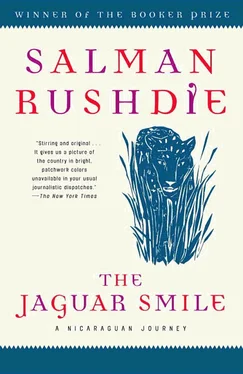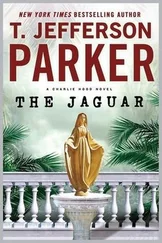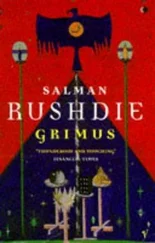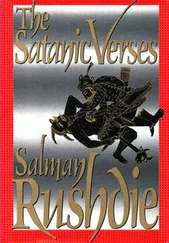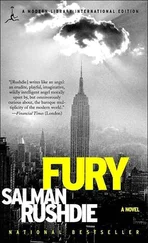Managua sprawled around its own corpse. Eighty per cent of the city’s buildings had fallen down in the great earthquake of 1972, and most of what used to be the centre was now an emptiness. Under Somoza, it had been left as a pile of rubble, and it wasn’t until after his fall that the mess was cleared up and grass was planted where downtown Managua used to be.
The hollow centre gave the city a provisional, film-set unreality. There was still a serious shortage of houses, and Managuans were obliged to improvise with what was left. The Foreign Ministry occupied an abandoned shopping mall. The National Assembly itself sat in a converted bank. The Intercontinental Hotel, a sawn-off concrete pyramid, had unfortunately failed to collapse. It stood amidst the wraiths of old Managua like an omen: an ugly American, but a survivor, nevertheless. (It became impossible, I discovered, not to see such a city in symbolic terms.)
People, too, were in short supply. Nicaragua’s population was under three million, and the war continued to reduce it. In my first hours in the city streets, I saw a number of sights that were familiar to eyes trained in India and Pakistan: the capital’s few buses, many of them donated quite recently by Alfonsín’s new Argentina, were crammed to bursting-point with people, who hung off them in a very subcontinental way. And the roadside shanties put up by the campesinos (peasants) who had come to Managua with hope and not much else, echoed the bustees of Calcutta and Bombay. Later I realized that these echoes of multitudinous lands were as misleading as the tyrant’s empty plinth. Nicaragua, which was about the size of the state of Oklahoma (if you turned England and Wales upside down, you’d have a rough approximation of its proportions), was also the emptiest of the countries of Central America. There were six times as many people in the New York metropolitan area as there were in the whole of Nicaragua. The void of downtown Managua revealed more than a crowded bus.
Filling the void, populating the streets, were the ghosts, the martyr dead. The Argentinian novelist Ernesto Sábato described Buenos Aires as a city whose street-names served to entomb the memory of its heroes, and in Nicaragua, too, I often had the feeling that everyone who mattered had already died and been immortalized in the names of hospitals, schools, theatres, highways or even (in the case of the great poet Rubén Darío) an entire town. In classical Greece, heroes could aspire to the status of gods, or at least hope to be turned into constellations, but the dead of an impoverished twentieth-century country had to make do with this more prosaic, public-park or sports-stadium immortality.
Of the ten earliest leaders of the Frente Sandinista de Liberación Nacional, nine had been killed before Somoza fell. Their faces, painted in the Sandinista colours of red and black, stared gigantically down on the Plaza de la Revolución. Carlos Fonseca (who had founded the Frente in 1956 and who fell in November, 1976, just two and a half years before the Sandinista victory); Silvio Mayorga; Germán Pomares: their names were like a litany. The survivor, Tomás Borge, now Minister of the Interior, was up there too, one living man among the immortals. Borge was badly tortured and, the story goes, ‘took his revenge’ on his torturer after the revolution, by forgiving him.
In a country whose history had been a continuous rite of blood for the forty-six years in which the Somozas had headed one of the longest-running and cruellest dictatorships on earth, it wasn’t surprising that a martyr-culture should have developed. Over and over, I heard the legends of the dead. Of the poet Leonel Rugama, who was trapped in a house by Somoza’s National Guard and ordered to surrender, and who yelled back, ‘Que se rinda tu madre!’ (Let your mother surrender!), and fought on until he died. Of Julio Buitrago, surrounded in a ‘safe house’ in Managua along with Gloria Campos and Doris Tijerino. Finally he was the only one left alive, resisting the might of Somoza’s tanks and heavy artillery hour after hour, while the whole country watched him on live television, because Somoza thought he’d captured a whole FSLN cell and wanted their destruction to be a lesson to the people; a terrible miscalculation, because when the people saw Buitrago come out shooting and die at last, when they saw that just one man had held off the tyrant for so long, they learned the wrong lesson: that resistance was possible.
In Nicaragua ‘at seven years’ the walls still spoke to the dead: Carlos, we’re getting there, the graffiti said; or, Julio, we have not forgotten.
A painting by the primitivist painter Gloria Guevara, titled Cristo guerrillero , showed a crucifixion set in a rocky, mountainous Nicaraguan landscape. Three peasant women, two kneeling, one standing, wept at the foot of the cross, upon which there hung a Christ-figure who wore, instead of a loincloth and a crown of thorns, a pair of jeans and a denim shirt. The picture explained a good deal. The religion of those who lived under the volcanoes of Central America had always had much to do with martyrdom, with the dead; and in Nicaragua many, many people found their way to the revolution through religion. The versicle-and-response format of the Mass now formed the basis of much political activity, too. Sandino’s old slogan, patria libre o morir (a free homeland or death), was now the national rallying-cry, and at the end of public meetings a platform speaker would invariably call out, ‘Patria libre!’ to which the crowd would roar back, rather spookily if you hadn’t shared their history, and if, for you, another, faraway martyr-culture, that of Khomeini’s Iran, represented a fearsome warning, ‘O MORIR!’
The Nicaraguan revolution had been, and remained, a passion . The word had secular as well as Christian resonances. It was that fusion that lay at the heart of Sandinismo. That was what Gloria Guevara’s painting revealed.
And then,
we’ll go wake our dead
with the life they bequeathed us
and we’ll all sing together
while concerts of birds
repeat our message
through the length and breadth
of America.
(From Until We’re Free , by Gioconda Belli.)
The generations of the dead were the context of seven-year-old ‘Nicaragua libre’, and without context there could be no meaning. When you stood in front of la Loma , the terrifying ‘bunker’ which had been the seat of the Somozas’ power, you began to remember: that the first Somoza, Anastasio Somoza García, had presided over the killing of some 20,000 Nicaraguans until he himself was shot, at a ball in León, by the poet Rigoberto López (who was himself killed by the National Guard an instant later); and that, after a brief period of (slight) liberalization under one of Tacho I’s sons, Luis, the other son resumed normal Somoza operations in 1967. This was Tacho II, last and greediest of the line. It was just seven years since the horror ended, seven years since men were fed to panthers in the despot’s private zoo, since torture, castration, rape. Seven years since the beast. La Loma made the United States’ claim that Nicaragua was once again a totalitarian state sound obscene. The bunker was the reality of totalitarianism, its hideous remnant and reminder. The beheaded, violated, mutilated ghosts of Nicaragua bore witness, every day, to what used to happen here, and must never happen again.
The most famous ghost, Augusto César Sandino, had by now been thoroughly mythologized, almost as thoroughly as, for example, Gandhi. A little, frowning man in a big hat, he had become a collection of stories. In 1927, he had been head of the sales department of the Huasteca petrol company in Mexico, when the Nicaraguan Liberal, Sacasa, backed by the army’s chief of staff, Moncada, rose in arms against the US-backed conservative, Adolfo Díaz. Sandino returned to Nicaragua to fight on the Liberal side, and when Moncada did a deal with the US and laid down his arms, Sandino refused, so that Moncada had to tell the Americans: ‘All my men surrender except one,’ and Sandino and his ‘Crazy Little Army’ took to the mountains … Yes, that story, and the story of his betrayal, his assassination by Somoza’s thugs in February 1934, after he had signed a peace treaty and when he was on his way home from the celebratory banquet. I was struck by the fact that it was Sandino’s hat, and not his face, that had become the most potent icon in Nicaragua. A hatless Sandino would not be instantly recognizable; but that hat no longer needed his presence beneath it to be evocative. In many instances, FSLN graffiti were followed by a schematic drawing of the celebrated headgear, a drawing that looked exactly like an infinity-sign with a conical volcano rising out of it. Infinity and eruptions: the illegitimate boy from Niquinohomo was now a cluster of metaphors. Or, to put it another way: Sandino had become his hat.
Читать дальше
